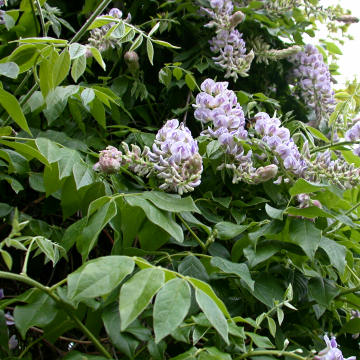

Wisteria frutescens - (image 1 of 6)
Taxonomy
Family: Fabaceae
Habitat
Moist or wet woods, thicket, swamp borders and shores.
Associates
Distribution
VA south to FL and TX, north to AR and further interior to southern IN and MO if considered with W. macrostachya. Planted as an ornamental and hardy zones 5 to 9.
Morphology
High climbing deciduous, twining, woody vine. Leaves alternate, odd-pinnate, to 30 cm long; leaflets 9-15, ovate-oblong or lance-ovate, 4-6 cm, acuminate, obscurely hairy beneath. Flowers fragrant, blue-purple, 1.5-2 cm, in long, compact racemes 4-15 cm long, at the end of short branches; pedicels 4-10 mm; axis, pedicels, and calyx finely pubescent and with some short-stipitate, oblong or clavate glands; calyx-tube campanulate, bilabiate, the upper 2 lobes broadly triangular to almost connate, forming an upper lip to about a third as long as the tube; lower lobes lanceolate, the median slightly longer; blade of the wing petal clawed, prolonged at the base into a linear auricle about as long as the claw and more or less parallel to it; keel up curved, auriculate at the base; stamens 10, diadelphous. Fruit 5-10 cm long, linear, flattened, dehiscent, glabrous, containing many rounded seeds.
Notes
Flowers late April to May (Dirr says June to August)
Wetland indicator: Facultative Wetland -
Kentucky Wisteria (W. macrostachya Nutt.) is similar but with the upper lip of the calyx about as long as the tube and with longer (15-30 cm) racemes, is sometimes included with W. frutescens. Japanese Wisteria (W. floribunda (Willd.) DC) typically has more leaflets (13-19) and pubescent ovary and fruit, possibly more aggressive than our native species.
References
Dirr, Michael A.
1998. Manual of Woody Landscape Plants: Their Identification, Ornamental
Characteristics, Culture, Propagation and Uses.
5th ed. Champaign, Illinois: Stipes Publishing L.L.C.
Gleason, Henry A. and A. Cronquist. 1991. Manual of Vascular Plants of Northeastern United States and Adjacent Canada. Second Ed.
The New York Botanical Garden. Bronx, NY
Swink, F. and G. Wilhelm. 1994. Plants of the Chicago Region.
Indiana Academy of Science. The Morton Arboretum. Lisle, Illinois.
|
Michael Hough © 2009 |